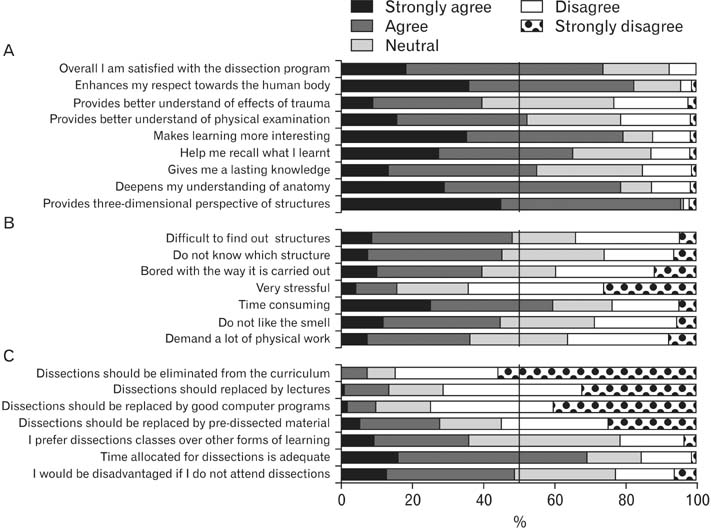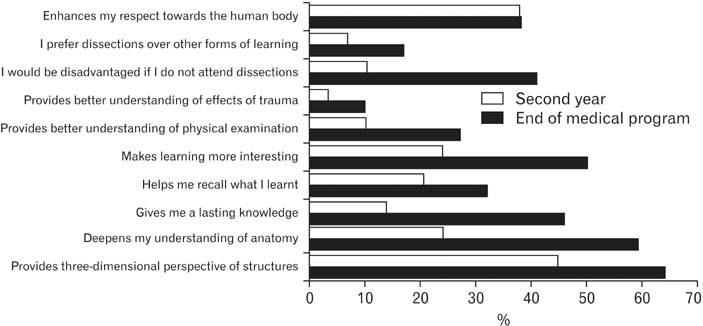Role of cadaveric dissections in modern medical curricula: a study on student perceptions
- Affiliations
-
- 1School of Medicine, Griffith University, Gold Coast, Australia. l.dissabandara@griffith.edu.au
- 2School of Medical Science, Griffith University, Gold Coast, Australia.
- KMID: 2424824
- DOI: http://doi.org/10.5115/acb.2015.48.3.205
Abstract
- The shift from traditional medical curricula to newer teaching and learning approaches such as problem-based learning has often resulted in omission or significant reduction of cadaveric dissections as a method of learning anatomy. The objective of this study was to evaluate students' perception of dissection in a graduate-entry, problem-based learning-based medical curriculum. At the end of the musculoskeletal dissection program in second year, a Likert-type questionnaire was used to explore medical student perceptions of the perceived advantages and challenges of cadaveric dissections in comparison with other anatomy teaching methods. Overall, a majority of students had a positive perception of dissections. Students who attended dissections regularly had significantly more positive perceptions about their experience and were in agreement with statements such as "dissections make learning more interesting" and "I would be disadvantaged if I did not attend dissection classes." Non-regular attendance was associated with statements about dissections such as "I do not like the smell," "time consuming," and "bored with the way it is carried-out." A follow-up study after completion of the medical program revealed a significant improvement of positive perception about dissection. Student perceptions appear to favour a role for cadaveric dissection in learning anatomy in modern medical curricula. However, optimal and effective integration of dissections is important, with consideration given to its structure and extent of content weighed against logistics and availability of resources; while addressing negative perceptions of dissection-based teaching.
Keyword
MeSH Terms
Figure
Cited by 5 articles
-
Comparison of decomposition rate of hind limbs of preserved mice with ethanol-glycerin and formaldehyde of advanced fixative solution
Amanda Natalie Wijaya, Ria Margiana, Sasanthy Kusumaningtyas, Deswaty Furqonita
Anat Cell Biol. 2021;54(2):225-231. doi: 10.5115/acb.20.314.The creation of a body donation program at Federal University of Juiz de Fora in Brazil: academic importance, challenges and donor profile
André Gustavo Fernandes de Oliveira, Augusto Ferreira Gonçalves, Júlia Nunes Soares, Letícia Henriques Neto Salgado, Bruno Silveira Santana, Matheus Venâncio Passos, Juliana Lopes de Oliveira Reis, Gustavo Candiá Arantes, Luís Filipe Sarmento Campos, Matheus Souza Carvalho, Lucas Cotrim Furtado da Gama, Alice Belleigoli Rezende
Anat Cell Biol. 2021;54(4):489-500. doi: 10.5115/acb.21.096.Anatomy teaching in Saudi medical colleges- is there necessity of the national core syllabus of anatomy
Srinivasa Rao Bolla, Radi Ali Al Saffar
Anat Cell Biol. 2022;55(3):367-372. doi: 10.5115/acb.22.041.Integrating virtual reality to enhance remote teaching of anatomy during unprecedented times
Thomas Boillat, Ivan James Prithishkumar, Dineshwary Suresh, Nerissa Naidoo
Anat Cell Biol. 2025;58(1):112-121. doi: 10.5115/acb.24.197.Profiles, tissue, and microbial integrity of cadavers used in medical faculties in South-western Uganda: implication in anatomical education
Elisa Ndyamuhakyi, Ibe Michael Usman, Jackim Nabona, Victor Adolf Fischer, Emeka Anyanwu, Elna Owembabazi, Wusa Makena, Ekom Monday Etukudo
Anat Cell Biol. 2025;58(1):99-111. doi: 10.5115/acb.24.159.
Reference
-
1. Willms JL, Schneiderman H, Algranati PS. Physical diagnosis: bedside evaluation of diagnosis and function. Baltimore, MD: William and Wilkins;1994.2. Shaffer K. Teaching anatomy in the digital world. N Engl J Med. 2004; 351:1279–1281.3. Heylings DJ. Anatomy 1999-2000: the curriculum, who teaches it and how? Med Educ. 2002; 36:702–710.4. Rizzolo LJ, Stewart WB, O'Brien M, Haims A, Rando W, Abrahams J, Dunne S, Wang S, Aden M. Design principles for developing an efficient clinical anatomy course. Med Teach. 2006; 28:142–151.5. Marks SC Jr. The role of three-dimensional information in health care and medical education: the implications for anatomy and dissection. Clin Anat. 2000; 13:448–452.6. McNulty JA, Halama J, Espiritu B. Evaluation of computer-aided instruction in the medical gross anatomy curriculum. Clin Anat. 2004; 17:73–78.7. Jastrow H, Vollrath L. Teaching and learning gross anatomy using modern electronic media based on the visible human project. Clin Anat. 2003; 16:44–54.8. Craig S, Tait N, Boers D, McAndrew D. Review of anatomy education in Australian and New Zealand medical schools. ANZ J Surg. 2010; 80:212–216.9. Weeks SE, Harris EE, Kinzey WG. Human gross anatomy: a crucial time to encourage respect and compassion in students. Clin Anat. 1995; 8:69–79.10. Azer SA, Eizenberg N. Do we need dissection in an integrated problem-based learning medical course? Perceptions of first- and second-year students. Surg Radiol Anat. 2007; 29:173–180.11. Cho MJ, Hwang YI. Students' perception of anatomy education at a Korean medical college with respect to time and contents. Anat Cell Biol. 2013; 46:157–162.12. Finkelstein P, Mathers LH. Post-traumatic stress among medical students in the anatomy dissection laboratory. Clin Anat. 1990; 3:219–226.13. Penney JC. Reactions of medical students to dissection. J Med Educ. 1985; 60:58–60.14. Evans EJ, Fitzgibbon GH. The dissecting room: reactions of first year medical students. Clin Anat. 1992; 5:311–320.15. Winkelmann A. Anatomical dissection as a teaching method in medical school: a review of the evidence. Med Educ. 2007; 41:15–22.16. IBM Corp. IBM SPSS statistics for windows. Version 21.0. Armonk, NY: IBM Corp.;2012.17. Zehra U, Athar Z, Hafeez A, Rizvi F. Is the use of PowerPoint presentations a better tool of understanding gross anatomy than cadaveric dissection? Ann Pak Inst Med Sci. 2012; 8:6–10.18. Joughin G. A short guide to oral assessment. Leeds: Leeds Metropolitan University;2010.19. MacKenzie L. Occupational therapy students as peer assessors in viva examinations. Assess Eval High Educ. 2000; 25:135–147.20. Silén C, Wirell S, Kvist J, Nylander E, Smedby O. Advanced 3D visualization in student-centred medical education. Med Teach. 2008; 30:e115–e124.21. Granger NA. Dissection laboratory is vital to medical gross anatomy education. Anat Rec B New Anat. 2004; 281:6–8.22. Schibeci RA, Riley JP 2nd. Influence of students' background and perceptions on science attitudes and achievement. J Res Sci Teach. 1986; 3:177–187.23. Tedman RA, Alexander H, Massa H, Moses D. Student perception of a new integrated anatomy practical program: does students' prior learning make a difference? Clin Anat. 2011; 24:664–670.
- Full Text Links
- Actions
-
Cited
- CITED
-
- Close
- Share
- Similar articles
-
- Nurses’ perceptions of gerontological nurse practitioner programme curricula: A qualitative descriptive study
- Effects of alternate dissection on anatomy learning
- Integrating artificial intelligence into medical curricula: perspectives of faculty and students in South Korea
- The Relationship between Perceptions of Nursing College Students regarding Clinical Practice Environment and Related Variables
- Improving Empathy in Nursing Students: A Comparative Longitudinal Study of Two Curricula




